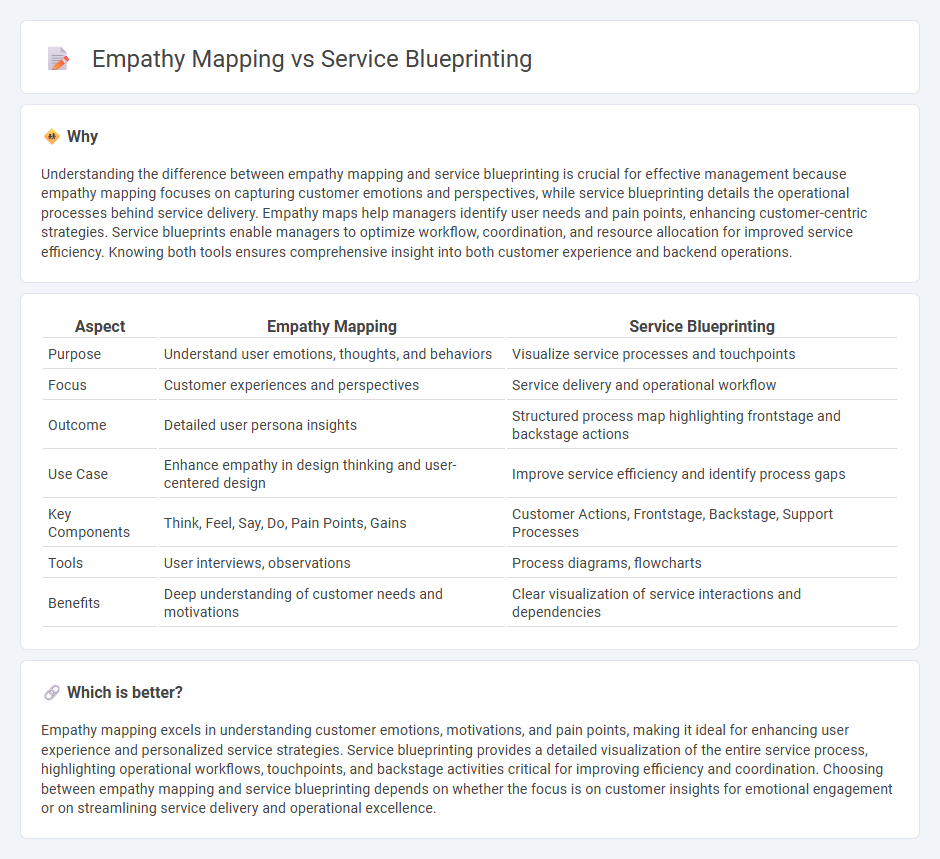
Empathy mapping and service blueprinting are essential tools in management for enhancing customer experience and service design. Empathy mapping focuses on understanding the customer's emotions, thoughts, and behaviors, while service blueprinting details the operational processes behind service delivery. Explore how these methodologies transform business strategies and improve user satisfaction.
Why it is important
Understanding the difference between empathy mapping and service blueprinting is crucial for effective management because empathy mapping focuses on capturing customer emotions and perspectives, while service blueprinting details the operational processes behind service delivery. Empathy maps help managers identify user needs and pain points, enhancing customer-centric strategies. Service blueprints enable managers to optimize workflow, coordination, and resource allocation for improved service efficiency. Knowing both tools ensures comprehensive insight into both customer experience and backend operations.
Comparison Table
| Aspect | Empathy Mapping | Service Blueprinting |
|---|---|---|
| Purpose | Understand user emotions, thoughts, and behaviors | Visualize service processes and touchpoints |
| Focus | Customer experiences and perspectives | Service delivery and operational workflow |
| Outcome | Detailed user persona insights | Structured process map highlighting frontstage and backstage actions |
| Use Case | Enhance empathy in design thinking and user-centered design | Improve service efficiency and identify process gaps |
| Key Components | Think, Feel, Say, Do, Pain Points, Gains | Customer Actions, Frontstage, Backstage, Support Processes |
| Tools | User interviews, observations | Process diagrams, flowcharts |
| Benefits | Deep understanding of customer needs and motivations | Clear visualization of service interactions and dependencies |
Which is better?
Empathy mapping excels in understanding customer emotions, motivations, and pain points, making it ideal for enhancing user experience and personalized service strategies. Service blueprinting provides a detailed visualization of the entire service process, highlighting operational workflows, touchpoints, and backstage activities critical for improving efficiency and coordination. Choosing between empathy mapping and service blueprinting depends on whether the focus is on customer insights for emotional engagement or on streamlining service delivery and operational excellence.
Connection
Empathy mapping and service blueprinting are interconnected tools in management that enhance customer experience understanding and service design precision. Empathy mapping captures detailed insights into customer emotions, thoughts, and behaviors, which inform the creation of accurate and user-centered service blueprints. Service blueprinting then translates these empathetic insights into structured workflows and touchpoints, optimizing operational processes and improving service delivery outcomes.
Key Terms
Service Blueprinting:
Service blueprinting provides a detailed visualization of service processes by mapping out frontstage customer interactions alongside backstage operations and support systems, emphasizing touchpoints, physical evidence, and employee actions. This methodological tool identifies potential service failures and opportunities for improvement by highlighting the connections between customer experiences and organizational workflows. Explore more about how service blueprinting enhances operational efficiency and customer satisfaction.
Touchpoints
Service blueprinting meticulously outlines every customer interaction touchpoint within the service delivery process, highlighting frontstage and backstage activities to improve operational efficiency. Empathy mapping concentrates on the emotional and cognitive touchpoints by capturing what customers say, think, feel, and do, allowing businesses to understand user experiences at a deeper level. Discover how integrating these tools refines customer journey insights for superior service design.
Frontstage/Backstage
Service blueprinting emphasizes detailed visualization of frontstage customer interactions and backstage operational processes, highlighting the connection between visible service delivery and internal support functions. Empathy mapping centers on understanding customer emotions, thoughts, and behaviors to enhance user-centered design, focusing primarily on the frontstage experience. Explore more to discover how these tools complement each other in refining service design and customer insights.
Source and External Links
What Is a Service Blueprint? [Examples and Templates] - Lucidchart - A service blueprint diagram visually maps out the steps in a service process, including customer actions, frontstage and backstage activities, and support processes, clarifying roles and interactions to improve or design services effectively.
What is Service Blueprinting | Precursive - Service blueprinting is a strategic tool that visually maps and analyzes the entire service process with a customer-centric approach, supporting continuous improvement and operational clarity through clear goals and visualization.
What Are Service Blueprints? - The Interaction Design Foundation - A service blueprint expands on customer journey maps by detailing every interaction and backend process involved in a service, helping teams align customer needs with business goals and streamline service design and operations.
 dowidth.com
dowidth.com